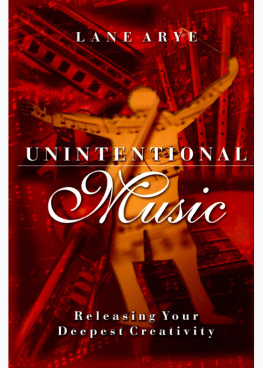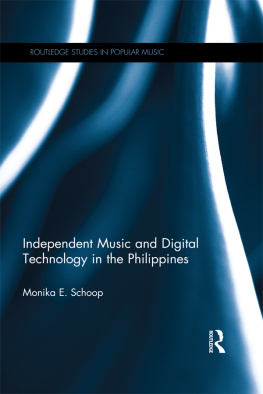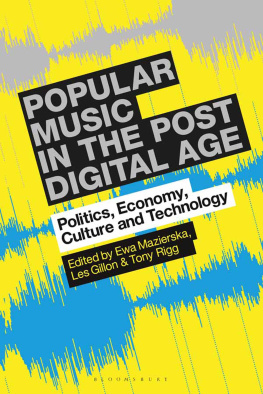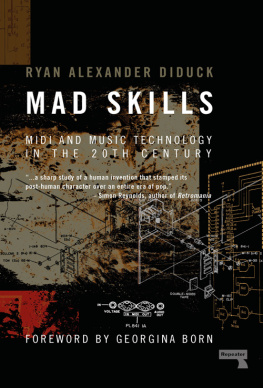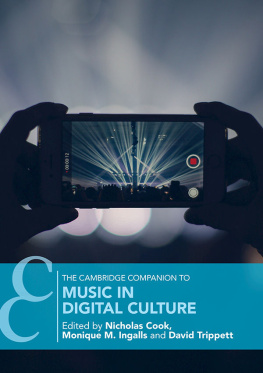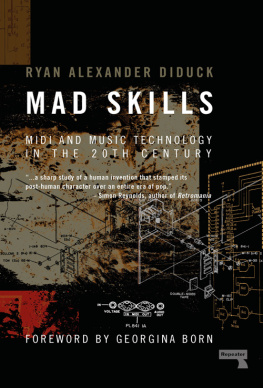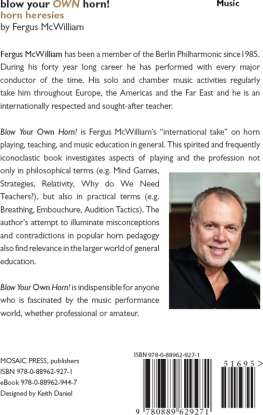POP MUSIC TECHNOLOGY AND CREATIVITY
Pop Music Technology and Creativity
Trevor Horn and the Digital Revolution
by
TIMOTHY WARNER
Lecturer in Music
at the University of Salford
First published 2003 by Ashgate Publishing
Reissued 2018 by Routledge
2 Park Square, Milton Park, Abingdon, Oxon OX14 4RN
711 Third Avenue, New York, NY 10017, USA
Copyright Timothy Warner 2003
Routledge is an imprint of the Taylor & Francis Group, an informa business
The author has asserted his moral right under the Copyright, Designs and Patents Act, 1988, to be identified as the author of this work.
All rights reserved. No part of this book may be reprinted or reproduced or utilised in any form or by any electronic, mechanical, or other means, now known or hereafter invented, including photocopying and recording, or in any information storage or retrieval system, without permission in writing from the publishers.
Notice:
Product or corporate names may be trademarks or registered trademarks, and are used only for identification and explanation without intent to infringe.
Publishers Note
The publisher has gone to great lengths to ensure the quality of this reprint but points out that some imperfections in the original copies may be apparent.
Disclaimer
The publisher has made every effort to trace copyright holders and welcomes correspondence from those they have been unable to contact.
A Library of Congress record exists under LC control number: 2002074728
ISBN 13: 978-1-138-63416-9 (hbk)
ISBN 13: 978-1-315-21128-2 (ebk)
Contents
List of Tables
General Editors Preface
The upheaval that occurred in musicology during the last two decades of the twentieth century has created a new urgency for the study of popular music alongside the development of new critical and theoretical models. A relativistic outlook has replaced the universal perspective of modernism (the international ambitions of the 12-note style); the grand narrative of the evolution and dissolution of tonality has been challenged, and emphasis has shifted to cultural context, reception and subject position. Together, these have conspired to eat away at the status of canonical composers and categories of high and low in music. A need has arisen, also, to recognize and address the emergence of crossovers, mixed and new genres, to engage in debates concerning the vexed problem of what constitutes authenticity in music and to offer a critique of music practice as the product of free, individual expression.
Popular musicology is now a vital and exciting area of scholarship, and the Ashgate Popular and Folk Music series aims to present the best research in the field. Authors will be concerned with locating musical practices, values and meanings in cultural context, and may draw upon methodologies and theories developed in cultural studies, semiotics, post-structuralism, psychology and sociology. The series will focus on popular musics of the twentieth and twenty-first centuries. It is designed to embrace the worlds popular musics from Acid Jazz to Zydeco, whether high-tech or low-tech, commercial or non-commercial, contemporary or traditional.
Professor Derek B. Scott
Chair of Music
University of Salford
Visit Project Pop: http://www.salford.ac.uk/FDTLpop/welcome.htm
Acknowledgements
I wish to thank all the friends and colleagues who have generously commented on my work. I am indebted to Trevor Horn who has kindly given permission to reproduce the interview included at the end of this book.
Introduction
This book is intended for all those - students and teachers, specialists and nonspecialists alike - who wish to approach pop music as an artistic, and not primarily as a social, cultural or historical phenomenon. Its main argument is that musical creativity in pop music is inextricably bound to developments in audio technology and the working practices which ensue. Because of the strength of this relationship, pop music differs in a number of important and significant ways from other kinds of popular music. This aspect is exemplified in this study through analysis of several recordings by Trevor Horn, who is widely acknowledged as the most important, innovative and successful British pop record producer of the early 1980s.
The book provides a definition of pop as distinct from rock music in the British context, highlights the key role of the record producer, shows the impact of the transition from analogue to digital technologies on the creative process, develops appropriate means of analysing pop music by focusing on the record as the central artefact, and seeks to promote a better understanding and appreciation of pop music from this perspective.
In this respect this study is at odds with dominant trends, which tend to explain pop music essentially as a sociocultural phenomenon. The current situation is largely the result of four interconnected factors: the nineteenth-century aesthetics and elitist prejudices against pop music of many musicologists; seminal, and largely negative texts by Marxist thinkers like Theodore Adorno (1903-69) - whose influence is still felt in cultural studies; the rejection of textual analysis, that is, close readings - as an ahistorical approach by the leading exponents of cultural studies; the fact that, within the broad umbrella of cultural studies, media or popular culture studies play down the specificity of each medium to concentrate on their common characteristics and functions in the consumer society and mass culture.
Musicology as an academic discipline was developed during the nineteenth century specifically in order to study works of Western European art music. As a consequence, any music that was outside this canon was firstly ignored and later studied through, and in relation to, established musicological methodology and terminology.
Adornos thought largely evolves from the same aesthetic stance as traditional musicology. His text On Popular Music, written over 50 years ago (Adorno 1990), remains profoundly influential. Adorno produces compelling arguments for viewing popular music as a force of social stasis, and the examples with which he supports his thesis are persuasive: popular music employs standard forms in which the parts seem almost interchangeable; popular music emphasizes regular metre; popular music does not aspire to create the same kind of artistic response as serious music; and popular music largely shuns the development of musical material. However, although the characteristics of popular music clearly differ from those of serious music, these differences only become weaknesses if one accepts a priori that the latter is some kind of ideal form to which all other musical artefacts should aspire. Adornos prejudices are apparent in the misleading musical classifications he adopts when he contrasts serious music with popular music.
The emerging discipline of cultural studies was sympathetic to Adornos view that the popular music produced by the culture industry was conformist and mind numbing, enforcing general acceptance of the capitalist order (Strinati, 1995, p. 63). However, the view of the consumer as an entirely disempowered and hoodwinked automaton, with a rather gross and brutal aesthetic, has come to appear both patronizing and unsupportable:



